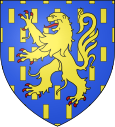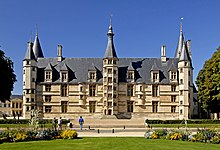Nevers
| Nevers | ||
|---|---|---|

|
|
|
| region | Bourgogne-Franche-Comté | |
| Department | Nièvre ( prefecture ) | |
| Arrondissement | Nevers | |
| Canton |
Chef-lieu from Nevers-1 Nevers-2 Nevers-3 Nevers-4 |
|
| Community association | Nevers | |
| Coordinates | 47 ° 0 ' N , 3 ° 9' E | |
| height | 167-238 m | |
| surface | 17.33 km 2 | |
| Residents | 32,990 (January 1, 2017) | |
| Population density | 1,904 inhabitants / km 2 | |
| Post Code | 58000 | |
| INSEE code | 58194 | |
| Website | http://www.nevers.fr/ | |
Nevers [ nəˈvɛʀ ] is a town with 32,990 inhabitants (as of January 1, 2017) in central France . Nevers is the prefecture (administrative center) in the department Nièvre in the region Bourgogne Franche-Comte . It was the capital of the historic Nivernais province .
geography
Nevers is located in a hilly area on the banks of the Loire , at the confluence with the Nièvre ; about 260 kilometers south of Paris .
history
The name of the city in Gallo-Roman times was Noviodunum , later it was changed to Nebirnum , after the name of the Nièvre river . With numerous archaeological finds, the importance of the settlement can already be proven at that time. It was long believed that Gaius Julius Caesar was here in 52 BC. . BC had built a supply depot before he opened to Gergovia . The camp, which is now assumed to be in today's Diou , housed everything that Caesar did not need for the battle: grain, military wages, replacement horses and hostages. The camp was conquered by a revolt of the Aeduern in the same year.
In the early Middle Ages , towards the end of the fifth century, Nevers became a bishopric, e.g. B. the legendary Deodatus . A secular fiefdom is only proven in the 10th century. The townspeople of Nevers received documented rights in 1194 and 1231. A university was still located here in the 14th century, which was moved here from Orléans , but later back again. In the 15th century, the Duchy of Nevers belonged to the ducal-Burgundian power and thus later to the hereditary lands of Charles the Bold . After the War of the Burgundian Succession (1477–1493) , it finally fell to the French crown in 1493.
Worth seeing
- Old town: Narrow streets that wind from the quays through the city are surrounded by numerous old town houses from the 14th to 17th centuries.
- Tour Goguin: The former corner tower of the medieval city fortifications, known as the Goguin Tower, stands on the banks of the Loire . It was built in the 12th century and later converted into a windmill.
- Porte du Croux: The square tower with corner turrets from the end of the 14th century is a relic of the old fortifications and was once the main entrance to the city from Paris . Today the Nivernais Museum of Archeology in it contains a collection of sculptures and (Roman) antiquities.
- Palais Ducal: The construction of the Ducal Palace of Nevers was commissioned by Count Jean de Clamency in 1464 and completed in 1491. Louis de Gonzague again made changes to the building. Today the Doge's Palace is one of the most important feudal buildings in central France. Each facade is flanked with a small crenellated corridor and a round tower. Today the palace is used for receptions and houses various departments of the city administration, for example the tourist office.
- Porte de Paris: The 18th century triumphal arch commemorates the victory in the War of Succession at the Battle of Fontenoy . Inside there is a hymn by Voltaire to the then King Louis XV and the construction dates.
- Petit Château La Gloriette: Small castle, right next to the Ducal Palace, which was built by Charles de Gonzague in the 15th century. Today it houses a police headquarters.
- Hôtel de Ville: The town hall was built in the 19th century and is one of the city's sights. The "Old Castle" stood there in front of the building. The influences of the French Revolution ( Liberté, Egalité, Fraternité (“Freedom, Equality, Fraternity”) above the entrance portal) are unmistakable on the front .
Sacred buildings
- The body of the holy compassionate sister Bernadette Soubirous (1858 Visionary of Lourdes) is since 1925 incorrupt in the chapel of the Espace Bernadette Soubirous (ehem. Kloster St. Gildard).
- St-Étienne de Nevers : The former priory church of Nevers is a masterpiece from the 11th century (construction began in 1068), a showpiece of Romanesque architecture in western Burgundy. A characteristic feature is the construction of an apse with three chapels extending radially to it. Saint Étienne (St. Stephen's Church) was founded by the monks of Cluny . The Nevers Cathedral has been a listed building since 1840.
- Cathedral of St-Cyr-Ste-Julitte : Among the sacred buildings, the cathedral actually consists of two buildings with two apses . Like the Porte du Croux, it has been a listed building since 1862. The apse and the transept in the west are remains of a Romanesque church building, while the central building and the eastern apse are of Gothic origin and can be dated to the 14th century. There is no transept in the eastern part of the building. In the north aisle there is a chapel dedicated to St. Bernadette Soubirous , whose life is also reminiscent of some windows. The church portal dates from the 15th century; the huge, artistically decorated tower ( Tour Boyer ), visible from afar, was built in the early 16th century.
- Peterskirche: The Peterskirche was built in the 17th century as a reminder of the collapsed parish church of Saint-Père. Inside there is a high altar from the same period and frescoes.
- Lady Chapel ( Sainte Marie ): The Lady Chapel, which has been a listed building since 1887, is characterized by a baroque facade in the style of Louis XIII. from what is unique at Nivernais . It was built in the first half of the 17th century as part of a monastery that was inhabited by the Sisters of the Visitation Order until its nationalization in the French Revolution .
- Sainte Bernadette du Banlay: The youngest church in Nevers is the Sainte Bernadette du Banlay, built by Claude Parent in 1966 . It is famous as an application example of modern French architecture with the so-called fonction oblique ("programmatic slant"). It is only open during services.
Facilities
- Nevers is the seat of a diocese .
- A court of first instance and commercial courts exist alongside the Chamber of Commerce.
education
Economy and Transport
The porcelain manufactory and distilleries are economically significant . Nevers is also a hub for agricultural products.
Nevers has had a train station on the Moret-Veneux-les-Sablons-Lyon-Perrache railway since 1850 . Furthermore, the railway lines to Chagny and Clamecy branch off in Nevers . South of Nevers, the route to Vierzon branches off in Saincaize .
The station is served by Intercités trains on the Paris-Bercy - Clermont-Ferrand and Nantes - Lyon-Perrache routes. In regional traffic, TER Bourgogne-Franche-Comté trains run to Paris-Bercy (or Cosne-sur-Loire ), Lyon-Perrache, Tours (or Bourges ) and Dijon-Ville .
Immediately south of the station is the Nevers railway bridge , built in 1850 , the first cast-iron railway bridge in France.
The Aéroport de Nevers-Fourchambault is only of secondary importance. During the Second World War, the Luftwaffe briefly used the airfield at Sangsue in June 1940 .
Town twinning
-
 Neubrandenburg in Mecklenburg-Western Pomerania , Germany
Neubrandenburg in Mecklenburg-Western Pomerania , Germany
-
 Mantua in ( Italy )
Mantua in ( Italy ) -
 Lund in ( Sweden )
Lund in ( Sweden ) -
 Saint-Albans in ( United Kingdom )
Saint-Albans in ( United Kingdom ) -
 Minsk in ( Belarus )
Minsk in ( Belarus ) -
 Hammamet in ( Tunisia )
Hammamet in ( Tunisia ) -
 Charleville-Mézières in ( France )
Charleville-Mézières in ( France ) -
 Curtea de Argeș in ( Romania )
Curtea de Argeș in ( Romania ) -
 Siedlce in ( Poland )
Siedlce in ( Poland ) -
 Sremska Mitrovica in ( Serbia )
Sremska Mitrovica in ( Serbia )
Personalities
Sons and daughters
- Pierre Louis Jules Marie Ameuille (1880–1947), medic
- Roselyne Bachelot (* 1946), politician
- Pierre Gaspard Chaumette (1763–1794), revolutionary
- Sébastien de Chaunac (born 1977), tennis player
- Auguste-Alexandre Ducrot (1817-1882), General
- Gauthier Grumier (* 1984), fencer
- Patrice Lafargue (* 1961), racing car driver and entrepreneur
- Jean-Louis Matinier (* 1963), accordion player
- Charles Rabot (1856–1944), geographer, researcher, traveler, mountaineer
- Johannes Ravisius (1480–1524), humanist
- Gustave Ruiz (1840 – after 1877), composer
- Henri Virlogeux (1924–1995), actor
particularities
The Magny-Cours Formula 1 circuit is located near Nevers.
Former Prime Minister of France Pierre Bérégovoy committed suicide in Nevers on May 1, 1993.
Nevers is a temporary location in the opera Euryanthe by Carl Maria von Weber
Nevers is the second location in Alain Resnai's feature film Hiroshima, mon amour (screenplay by Marguerite Duras ), but does not get off very well, since its residents punished a young girl who was in love with a German soldier with the greatest contempt and torment during World War II .
Nevers is the second location in Eric Rohmer's feature film Conte d'Hiver (1992).
literature
- Le Patrimoine des Communes de la Nièvre. Volume 2, Flohic Editions, Charenton-le-Pont 1999, ISBN 2-84234-054-X , pp. 704-768.









